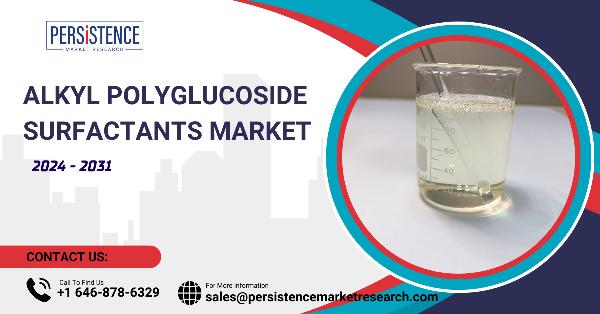Are there any recent advancements in alkyl polyglucoside surfactants technology?

Strong 8k brings an ultra-HD IPTV experience to your living room and your pocket.
Alkyl polyglucosides (APGs) have long been valued in various industries for their biodegradable, non-toxic, and effective properties. As consumer demand for eco-friendly and sustainable products continues to rise, the technology behind APG surfactants has seen several notable advancements. These innovations enhance the performance, efficiency, and applications of APGs, reflecting the industry's commitment to improving environmental impact and meeting evolving market needs. This article explores the recent technological advancements in alkyl polyglucoside surfactants, highlighting key developments that are shaping the future of this sector.
For More Industry Insight: https://www.persistencemarketresearch.com/market-research/alkyl-polyglucoside-surfactants-market.asp
1. Enhanced Glycosylation Processes
Recent advancements in the glycosylation process—the chemical reaction that combines fatty alcohols with glucose to produce APGs—have led to significant improvements in efficiency and product quality. Key developments include:
Catalyst Innovations: New and improved catalysts are being used to enhance the glycosylation reaction. These advanced catalysts increase reaction rates and selectivity, reducing production costs and improving yields. Research is focused on developing catalysts that are more efficient, environmentally friendly, and capable of operating under milder conditions.
Process Optimization: Advances in process engineering have led to the optimization of reaction conditions, such as temperature, pressure, and reaction time. These improvements help in achieving better control over the reaction, leading to higher purity and consistency of the final APG products.
2. Sustainable Raw Material Sourcing
The sustainability of APG production is a key focus area, with recent advancements aimed at improving the environmental impact of raw material sourcing:
Renewable Feedstocks: There has been a shift towards using more sustainable and renewable feedstocks for fatty alcohols and glucose. For instance, the use of plant-based oils that are certified as sustainable reduces the environmental footprint of APG production. Researchers are exploring new sources of biomass that can be converted into fatty alcohols and glucose more efficiently.
Biotechnological Approaches: Biotechnology is being leveraged to enhance the production of glucose from renewable sources. Enzymatic processes, including the use of genetically modified microorganisms, are being developed to increase the yield and reduce the energy requirements for glucose production.
3. Improved Formulation and Application
Technological advancements have also improved the formulation and application of APG surfactants, broadening their use across various industries:
Advanced Formulation Techniques: Innovations in formulation technology have led to the development of APG-based products with enhanced properties. These include better foaming ability, improved emulsification, and greater stability in a range of conditions. Techniques such as microencapsulation and nanotechnology are being explored to enhance the performance and functionality of APG surfactants in different applications.
Tailored Solutions for Specific Applications: Recent advancements have enabled the customization of APG surfactants to meet the specific needs of various industries. For example, in the personal care sector, APGs can be tailored to enhance skin compatibility and sensory attributes. In the industrial sector, modifications can improve cleaning efficiency and stability under harsh conditions.
4. Environmental Impact Reduction
Reducing the environmental impact of APG production and use remains a top priority, with recent advancements focusing on minimizing waste and energy consumption:
Waste Reduction Technologies: Advances in process technology have led to more efficient use of raw materials and reduced waste generation. Techniques such as recycling and reusing by-products are being implemented to minimize the environmental footprint of APG production.
Energy Efficiency: New technologies are being developed to improve energy efficiency in the production process. These include the adoption of energy-efficient reactors, heat recovery systems, and renewable energy sources. Such innovations contribute to a lower carbon footprint and a more sustainable production process.
5. Regulatory and Certification Advances
Recent developments in regulatory standards and certifications have also impacted the APG surfactants industry:
Enhanced Regulatory Compliance: The APG industry is seeing stricter regulations and standards related to environmental impact and product safety. Recent advancements include the development of new testing methods and compliance protocols that ensure APG surfactants meet these standards.
Certification Programs: Certification programs for sustainability and environmental impact, such as those from organizations like EcoLabel and Cradle to Cradle, are gaining prominence. These certifications provide consumers and manufacturers with assurances regarding the eco-friendliness of APG products.
6. Research and Development Initiatives
Ongoing research and development efforts are driving innovation in APG technology:
Academic and Industrial Collaboration: Collaborations between academic institutions and industry leaders are fostering innovation in APG technology. Research focuses on exploring new applications, improving production processes, and developing next-generation APG surfactants.
Investment in R&D: Increased investment in research and development is accelerating the pace of technological advancements. Funding is being directed towards exploring new raw materials, refining production techniques, and enhancing the performance of APG surfactants.
Note: IndiBlogHub features both user-submitted and editorial content. We do not verify third-party contributions. Read our Disclaimer and Privacy Policyfor details.


